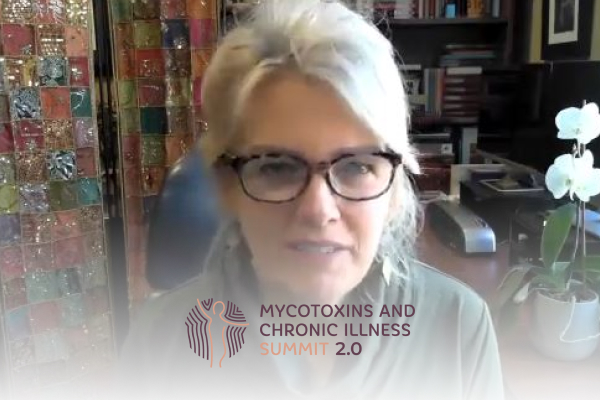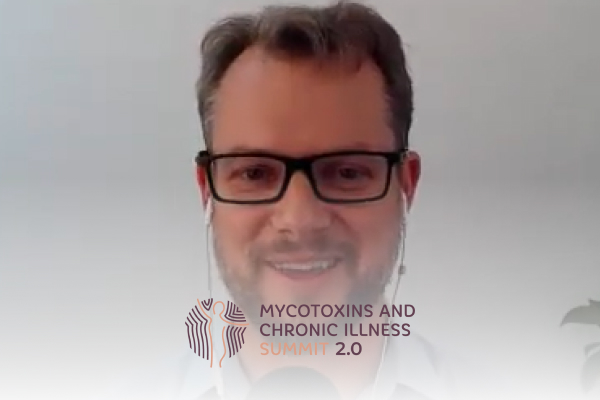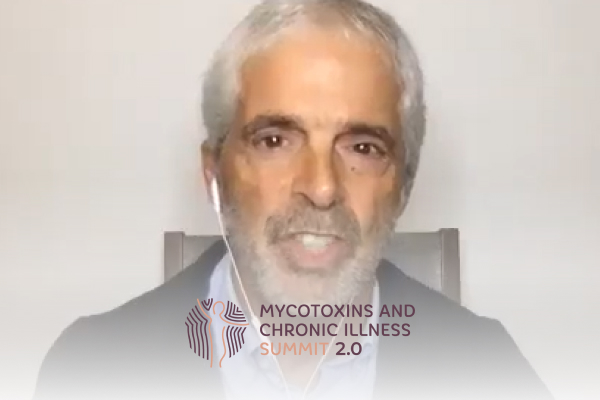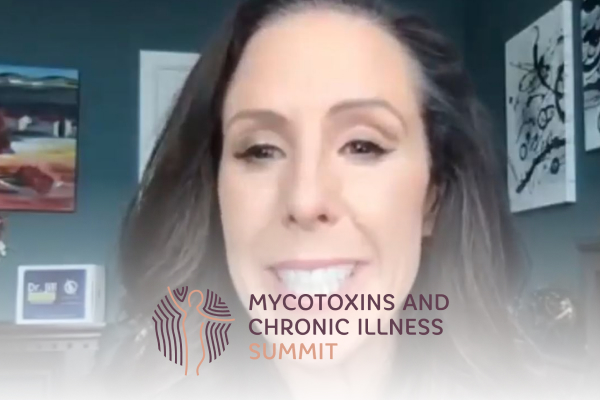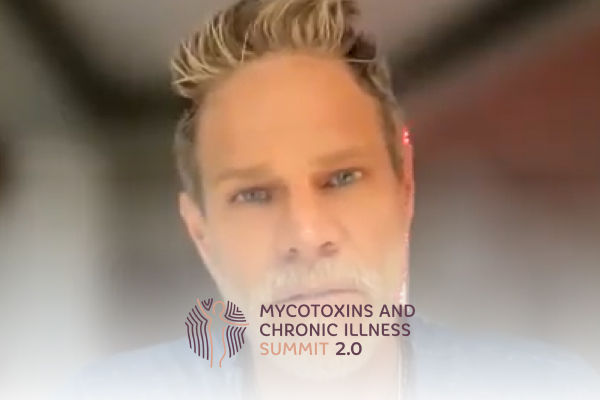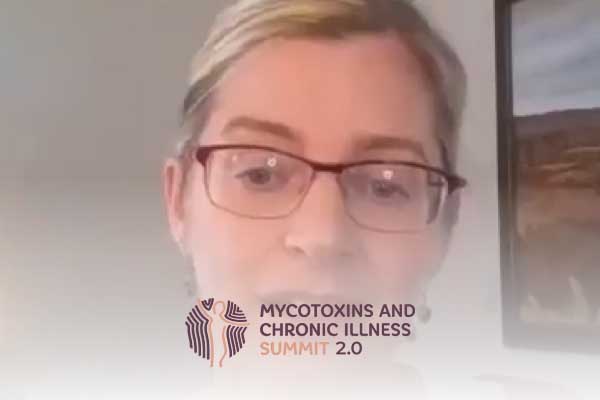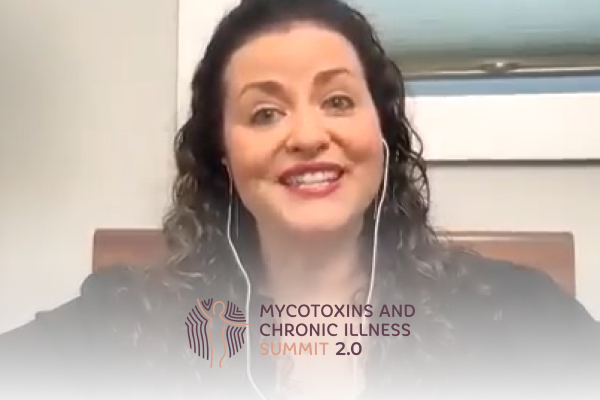Join the discussion below

Nafysa Parpia, ND has an independent practice at Gordon Medical associates, specializing in the treatment of Lyme disease and other complex chronic illnesses such as autoimmunity, mold toxicity, fibromyalgia, environmental toxicity and gastrointestinal disorders. Her patients with chronic Lyme Disease are typically those who either do not do well with antibiotics, or prefer... Read More
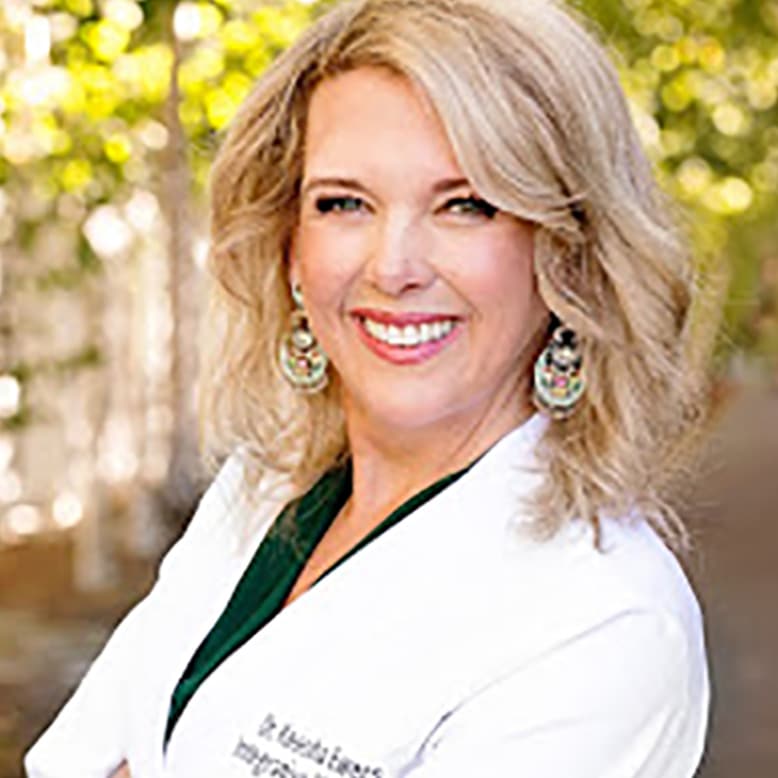
Keesha Ewers, PhD, ARNP-FNP-C, AAP, IFM-C
Dr. Keesha Ewers is an integrative medicine expert, Doctor of Sexology, Family Practice ARNP, Psychotherapist, herbalist, is board certified in functional medicine and Ayurvedic medicine, and is the founder and medical director of the Academy for Integrative Medicine Health Coach Certification Program. Dr. Keesha has been in the medical field... Read More
- Why it is important to understand that everyone has trauma.
- The first steps you can take to heal childhood trauma.
- How trauma can show up as symptoms and diseases.
Nafysa Parpia, N.D.
Welcome this episode of the Mycotoxin and Chronic Illness Summit. I’m so happy to have with me today Dr. Keesha Ewers. Today, we’re gonna talk about trauma, leaky boundaries, leaky gut, and the connection to mycotoxin illness. Keesha, will you please introduce yourself to our audience?
Keesha Ewers, PhD, ARNP-FNP-C, AAP, IFM-C
Sure, it’s so good to be here again. My name is Keesha Ewers and I have a PhD in sexology and I’m a family practice advanced registered nurse practitioner or ARNP with specialty in integrative medicine. I’m a psychotherapist including using plant medicines for healing trauma, MDMA certified psychotherapist, and a certified conscious dying doula and the founder of the Academy for Integrative Medicine Health Coach Certification Program and the author of “Solving the Autoimmune Puzzle” and “The Quick and Easy Autoimmune Paleo Cookbook.”
Nafysa Parpia, N.D.
It’s so great to have you here, Keesha. I love all the myriad of beautiful things that you have explored in this life and then explore with your patience, what you’ve learned, what you give to them. So thank you for all that you do and–
Keesha Ewers, PhD, ARNP-FNP-C, AAP, IFM-C
Thank you.
Nafysa Parpia, N.D.
I think–
Keesha Ewers, PhD, ARNP-FNP-C, AAP, IFM-C
I like you have a passion for it, right?
Nafysa Parpia, N.D.
Yes.
Keesha Ewers, PhD, ARNP-FNP-C, AAP, IFM-C
That’s the only reason we’re here.
Nafysa Parpia, N.D.
Sure is. Yeah, thanks for being here. So tell us about how you came to this work.
Keesha Ewers, PhD, ARNP-FNP-C, AAP, IFM-C
You know, I was a 19 year old registered nurse in a kind of high intensity, high adrenaline. I was an adrenaline junkie, you know, life flight and intensive care unit and balloon pump team, I think just loved all of the high intensity stuff. And I was running marathons and having children and raise four small children, when in my early 30s I was diagnosed with rheumatoid arthritis and you know, that was really remarkable because just like my patients will come to me and say, all of a sudden I’m sick, that’s how I experienced it too. And of course we know that’s not true, it’s not all of a sudden, it takes a lot of years to have a fully developed ICD-10 code, you know, illness, right? Takes a long time to get there.
Nafysa Parpia, N.D.
Exactly.
Keesha Ewers, PhD, ARNP-FNP-C, AAP, IFM-C
To have that diagnostic code attached to it. But I had been imbalance for a really long time and just didn’t know the language that my body spoken. I didn’t realize that it had been trying to tell me over the years, I would just… I used a lot of Advil, I took Accutane when I was 19 for acne, you know, would use antibiotics or repeat a kind of chronic ear infections and strep throat. So I was always treating something when I would get run down. I would get an instant sore throat, I’d get pain in my feet because of all my running and I would just pop Advil. So my body was trying to tell me that it was having troubles and I just didn’t listen to it.
Nafysa Parpia, N.D.
You were only 19 when you started having…
Keesha Ewers, PhD, ARNP-FNP-C, AAP, IFM-C
Well, yeah, between the ages of 19 and 30 until I was diagnosed with RA.
Nafysa Parpia, N.D.
Okay.
Keesha Ewers, PhD, ARNP-FNP-C, AAP, IFM-C
Yeah, and I had four kids in that period of time and I had to have my gallbladder out ’cause I had polycystic and you know, I mean, just a lot of things happen. I had my tonsils out in that period of time and it was a all in the sort of Western medical paradigm, right? Like this is causing you trouble. So let’s take it out instead of what’s going on underneath it at all and what can we do to get to the root cause that wasn’t even in the language of what, you know, I’d been trained in. And so, you know, I didn’t realize that all of these were signs of an imbalance that my body was trying to get my attention with. So, you know, when I was diagnosed with RA, I had gone in that morning, I’d woken up just overnight with 10 extra pounds of puffiness all over my body and my joints and I was red and inflamed in a lot of pain. And it was like someone had just taken the batteries out of the Energizer Bunny, that’s what my friends used to call me. I was the Energizer Bunny . And so–
Nafysa Parpia, N.D.
Keesha–
Keesha Ewers, PhD, ARNP-FNP-C, AAP, IFM-C
I went in and the doctor said, “Do you have a history of autoimmune disease in your family?” And I said, “Well, my grandfather, I think had rheumatoid arthritis.” And my grandfather died at the age I am right now. I just turned 57 yesterday and this…
Nafysa Parpia, N.D.
Happy birthday, Keesha.
Keesha Ewers, PhD, ARNP-FNP-C, AAP, IFM-C
Yeah, thank you.
Nafysa Parpia, N.D.
Yeah.
Keesha Ewers, PhD, ARNP-FNP-C, AAP, IFM-C
And this is when he died of this disease in a wheelchair, right? And so she said, “Well, that’s what you have and you know, like here are two prescriptions. One’s for methotrexate and one is for a very strong non-steroidal anti-inflammatory drug. Come back when you’re worse, not if you get worse and we’ll change your meds, right?” And I just stopped her. I said, “Well, hang on just a second. Is there anything else that I can do? I’m very disciplined, I make my own food, you know, I’ll do anything.” And she said, “No, it’s genetic. Like, that’s it.” So I just remember driving home and thinking there has to be a difference, a different paradigm out there somewhere than this one, that has a different answer to the question I’m asking. And so I started exploring. And so that’s how I really got into this.
I found PubMed article on yoga and autoimmune disease, went to my first yoga class the next day and the yoga teacher said just enough about this word, Ayurvedic medicine, that I went home and researched that. And the internet told me that Ayurveda 10,000 years ago said that autoimmune disease is undigested anger. And I remember sitting back in my chair and thinking, “I’m not an angry person, and yet I have an autoimmune disease.” And then realizing that maybe that was actually part of the issue that I didn’t allow anger, I didn’t recognize it, I wasn’t able to track myself, and it was just all being stored in my body. And that maybe I was very disconnected from my head, you know, from my body and maybe this was part of my problem. And so I learned to meditate and started training to become a yoga teacher. And in that process, I remember having the word autoimmune, just kind of dancing in front of my third eye space one day when I was meditating and thinking like, autoimmune, looking at this word, you know?
Nafysa Parpia, N.D.
Yeah.
Keesha Ewers, PhD, ARNP-FNP-C, AAP, IFM-C
That means I’m attacking myself.
Nafysa Parpia, N.D.
Right.
Keesha Ewers, PhD, ARNP-FNP-C, AAP, IFM-C
Right? That means I’m killing myself literally. And I just remember thinking, when is the first time I wanted to die. Like, why am I killing myself? Because I don’t wanna die right now. And so that was a very important way of framing it for me. And as I went backwards in my meditation looking for that time period that maybe I did wanna die, I found a 10-year-old little girl version of myself that was being sexually abused by the vice principal of the elementary school.
Nafysa Parpia, N.D.
I’m so sorry.
Keesha Ewers, PhD, ARNP-FNP-C, AAP, IFM-C
Yeah, and I remember looking at her and thinking, “Oh, she wanted off the planet, she wanted to die.” And my dad was out to… You know, out to sea in the Navy at that time, I tried to tell my mom that something was going on, but I don’t think I had the right words. And you know, I just didn’t know what to do and was confused. And so I remember looking at that little girl and going, “Oh, I’ll bet that this time period has something to do 20 years later with what’s happening right now with my body.”
Nafysa Parpia, N.D.
Yeah.
Keesha Ewers, PhD, ARNP-FNP-C, AAP, IFM-C
And sure enough science tells us that that’s true.
Nafysa Parpia, N.D.
But you–
Keesha Ewers, PhD, ARNP-FNP-C, AAP, IFM-C
That it absolutely is connected. And so luckily what I did was dive right into trauma healing, ’cause I realized it had to be connected. And within six months my RA was gone and it’s never been back.
Nafysa Parpia, N.D.
What a moving story.
Keesha Ewers, PhD, ARNP-FNP-C, AAP, IFM-C
Yeah.
Nafysa Parpia, N.D.
Sad, beautiful and–
Keesha Ewers, PhD, ARNP-FNP-C, AAP, IFM-C
Yeah, people would hear that and they’ll say, “Oh my gosh, that’s a moving story, That’s a terrible story.” And then they’ll say, like if they didn’t experience sexual abuse and I’m just praying that no one that’s hearing my voice has, the unfortunate truth is one in four people have that are reported, right? Which means there’s more. But the thing of it is, is that story includes what we can call a capital T trauma, but there are lower case T traumas too, every human has had trauma. So sometimes when I tell that story, people will think, “Well, I had a really good childhood, I never had any of those things happen to me. So this isn’t relevant to me.” And I just wanna kind of bring everyone back into the conversation and say it’s relevant to everyone because wherever our bar is set, our level of trauma is the worst trauma we’ve ever had.
Nafysa Parpia, N.D.
Right, part of the human condition, whether it is sexual abuse or some kind of psychological or emotional abuse or self introduced.
Keesha Ewers, PhD, ARNP-FNP-C, AAP, IFM-C
Intellect embodiment, yeah.
Nafysa Parpia, N.D.
Right, it’s something–
Keesha Ewers, PhD, ARNP-FNP-C, AAP, IFM-C
It’s something, yeah.
Nafysa Parpia, N.D.
That’s happened to each human, as the Buddhist say, “Every human is suffering, we’re all in the same boat.” The suffering might look different, it does look different for each person, but we do have that in common.
Keesha Ewers, PhD, ARNP-FNP-C, AAP, IFM-C
Exactly. Yeah, and that’s exactly true and research tells us, you know, with looking at, there was a study that I looked at in my doctoral work where I went, oh my goodness, you know, because I’d already seen a lot of pet scans of brains, FMRI scans, looking at brain architecture changes to… In response to trauma that had been diagnosed as post-traumatic stress disorder, so in, you know, diagnostic code PTSD, this is what the brain looks like. Kind of like the old ’80s commercial, this is your brain on drugs with the egg dropping into the , right? This is your brain on trauma, right?
That’s… And the scans were the same, like for every human that had had PTSD that was scanned, there was some form of a shrinkage in the prefrontal cortex up here, which is your adult brain that helps you make executive functions, like who to hang out with, how to spend your money, what to eat, like, you know, all of your day to day adult functioning. And a growth in the child part of the brain, the limbic system in the right sided amygdala, like the volume was increased in that limbic system of amygdala. With PTSD, well, a study showed that when they gave the participants personal stress inventory to take, you know, that’s the one where you say, have you moved in the last year? Have you gotten married? Gotten divorced? Gotten a job? Gotten laid off? Had children? Have been empty nested? You know, like all of it, right? All of the normal stresses of a regular human life,
Nafysa Parpia, N.D.
Right.
Keesha Ewers, PhD, ARNP-FNP-C, AAP, IFM-C
When people reported themselves as being chronically overwhelmed and having a high personal stress inventory, which there’s not a human in my world that, you know, that comes to see me, that doesn’t have high perceived stress.
Nafysa Parpia, N.D.
Me neither.
Keesha Ewers, PhD, ARNP-FNP-C, AAP, IFM-C
Right, it’s kind of the life that we’ve generated in our era.
Nafysa Parpia, N.D.
Right.
Keesha Ewers, PhD, ARNP-FNP-C, AAP, IFM-C
And it’s very fast paced, it’s very productivity oriented, it’s very achievement oriented and you know, it’s very materialistic. And so that actually changes the brain architecture the same as PTSD. If you think of yourself as overwhelmed and overscheduled you get the same brain changes as somebody that has PTSD, it’s crazy. That’s the lowercase t trauma.
Nafysa Parpia, N.D.
Right.
Keesha Ewers, PhD, ARNP-FNP-C, AAP, IFM-C
Yeah.
Nafysa Parpia, N.D.
It makes so much sense because we all have these stresses and they’re cumulative.
Keesha Ewers, PhD, ARNP-FNP-C, AAP, IFM-C
Right.
Nafysa Parpia, N.D.
Some of us from the time we were born all the way up. And so it’s like this constant effect on our brain’s neuroplasticity. Whether it’s a capital T or a small t, we could have many small Ts and they add up and can equate a few large Ts.
Keesha Ewers, PhD, ARNP-FNP-C, AAP, IFM-C
Exactly, exactly.
Nafysa Parpia, N.D.
Biochemically, physically.
Keesha Ewers, PhD, ARNP-FNP-C, AAP, IFM-C
Right. So then that increases your… Okay, so you have this perception that you’re stressed out all the time, then your brain messenger chemicals, your neurotransmitters will send the message down to the adrenal glands, that you’re a zebra being chased by a lion and you’re about to get eaten for dinner. The adrenals will respond as if you are a zebra being chased by a lion and about to get eaten for dinner. So cortisol goes pumping out into your system, your reproductive hormones come into silence, your digestive system comes into calm and quiet and you have cortisol going out there to increase your heart rate, increase your blood pressure so that you can get away from said lion.
But you know, if we’re constantly perceiving ourselves as unsafe, not good enough, not beautiful enough, not smart enough, not whatever it is, not safe, not safe, not safe, not safe, then what will happen is that cortisol will break down the lining of the gut. So you wind up with leaky gut. And if you wind up with leaky gut and that immune system which is supposed to do this, supposed to do this, it’s not misbehaving. It’s supposed to go after anything that it reads as not you. So then foods that you eat a lot are coming through that gut wall. The immune system is marshaling an attack against this thing that is reading is not you, which could be blueberries, broccoli, salmon and coconut oil, right? and you wind up being, you know, hyper reactive with your immune system. Well, guess what happens when you’re exposed to mycotoxins, you’re gonna, you know, have an exaggerated response to it.
Nafysa Parpia, N.D.
Yes.
Keesha Ewers, PhD, ARNP-FNP-C, AAP, IFM-C
Yeah, this is where mass cell activation happens.
Nafysa Parpia, N.D.
Absolutely.
Keesha Ewers, PhD, ARNP-FNP-C, AAP, IFM-C
And intolerance to chemicals and histamines.
Nafysa Parpia, N.D.
Yeah. And then there’s research also that shows that stress causes immune dysregulation. So we have people who have…
Keesha Ewers, PhD, ARNP-FNP-C, AAP, IFM-C
Arthritis which is destructing, right?
Nafysa Parpia, N.D.
Right.
Keesha Ewers, PhD, ARNP-FNP-C, AAP, IFM-C
I mean, dysregulation.
Nafysa Parpia, N.D.
Yeah, exactly. A hyperactive immune system with the mass cells and the autoimmune conditions. So ties it right back to what you started talking about, the auto immunity and the stress, then at the same time they’re not able to mount the appropriate immune response to kill off the infections.
Keesha Ewers, PhD, ARNP-FNP-C, AAP, IFM-C
Right.
Nafysa Parpia, N.D.
And so we loop it back to one of the most important pieces being trauma, whether it’s big T or small t–
Keesha Ewers, PhD, ARNP-FNP-C, AAP, IFM-C
Right.
Nafysa Parpia, N.D.
It will it effect over time.
Keesha Ewers, PhD, ARNP-FNP-C, AAP, IFM-C
The way that I always think about it in my mind, ’cause I’m very visual, is I used to play chess with my dad. And you know, if you keep leading with those pawns, it’s like your lymphocytes, right? You keep growing them into the fray to fight off broccoli.
Nafysa Parpia, N.D.
Right.
Keesha Ewers, PhD, ARNP-FNP-C, AAP, IFM-C
Then when the big bad guy comes along, COVID or Epstein-Barr or herpes, you know, or chickenpox virus and you wind up with, you know, this varicella with or lovely shingles, right?
Nafysa Parpia, N.D.
Right.
Keesha Ewers, PhD, ARNP-FNP-C, AAP, IFM-C
And there’s nothing left on the board, yeah.
Nafysa Parpia, N.D.
Yeah, it’s true. So many different illnesses can come about then at that point.
Keesha Ewers, PhD, ARNP-FNP-C, AAP, IFM-C
Right.
Nafysa Parpia, N.D.
Because it’s true, it might sound… Telling the audience, it might sound like we’re joking when we talk about being sensitive to broccoli, but it’s true. There are a lot of patients out there who are sensitive to the things that are supposed to be most benign.
Keesha Ewers, PhD, ARNP-FNP-C, AAP, IFM-C
I’m not joking.
Nafysa Parpia, N.D.
It’s just–
Keesha Ewers, PhD, ARNP-FNP-C, AAP, IFM-C
Like this is what I see day in and day out in my practice and people will look at their food sensitivity tests and say, “I thought sweet potatoes were supposed to be good for me, or I thought coconut oil was good for me.” And the problem is that when you have a what’s good for you list that someone’s written in a book, you know, a functional medicine book or a blog post, your body has its own individual reactivity that’s going on. And so, you know, there’s really nothing that your body’s going to say it’s good for if it’s got this whole immune dysregulation going on, you know, it’s barking and biting first before asking questions. And so that’s what we wanna do, is we wanna calm it down.
Nafysa Parpia, N.D.
Right.
Keesha Ewers, PhD, ARNP-FNP-C, AAP, IFM-C
So we ask questions first .
Nafysa Parpia, N.D.
Yes, so it’s not a one size, its all treatment protocol–
Keesha Ewers, PhD, ARNP-FNP-C, AAP, IFM-C
Right.
Nafysa Parpia, N.D.
At all, not at all. So we’re really doing personalized medicine here, working with patients in their food reactivities, but also taking it even further. Where does the trauma lay in? How do we heal that while we’re working with the biochemistry of the person as well?
Keesha Ewers, PhD, ARNP-FNP-C, AAP, IFM-C
I mean, it all really starts, like that cortisol response from the adrenal starts here, not down to the adrenal glands, right?
Nafysa Parpia, N.D.
Right.
Keesha Ewers, PhD, ARNP-FNP-C, AAP, IFM-C
It starts with perceptions.
Nafysa Parpia, N.D.
Right.
Keesha Ewers, PhD, ARNP-FNP-C, AAP, IFM-C
And so working at that level is essential. Like sometimes practitioners will specialize in teaching emotional freedom technique, for example, or somatic body healing, trauma release exercises, shaking, different thing, you know, breath work. These are all fantastic to relieve that overload in the nervous system. However, if we’re starting with vagal nerve toner, you know, things like this, we’re missing it because we have to start here with what is even activating it. Can we stop the activation process in the first place rather than trying to slow it down, you know? So that’s where I see a lot of this going awry. It’s great to stop your nervous system from getting overwhelmed, but what about preventing it?
Nafysa Parpia, N.D.
Right, right. So tell us about ways that you begin to help patients heal the past childhood trauma.
Keesha Ewers, PhD, ARNP-FNP-C, AAP, IFM-C
Yeah. So one of the ways that I work with people is to first explore what were the meanings and beliefs they created in response to working inside, growing up inside of their family or caregivers of origin, whatever that looked like for them. And we really just start exploring what are the meanings that each person made up about these different events that occur on the human growth and developmental, right? Chronicle line, you could say. We’re not linear. And so the way that I always think about it is because we’re not linear and quantum physics tells us time is not linear, the person that we’re going to be when we die is available to the person we were when we were first born. And so wherever we heal trauma in this moment, we’re healing the past and the future. And that’s powerful, okay?
Nafysa Parpia, N.D.
I absolutely believe that too.
Keesha Ewers, PhD, ARNP-FNP-C, AAP, IFM-C
Biocentrism, biocentric design.
Nafysa Parpia, N.D.
Yes.
Keesha Ewers, PhD, ARNP-FNP-C, AAP, IFM-C
And quantum physics. There’s a great book by Robert Lanza called “Biocentric Design” that’s really great. That shows the scientific proof of that, right? Where a lot of mystical spiritual practices throughout time have set that now our science is showing it, which is very, very cool. So I start with where you are today. You don’t have to go back and relive trauma, you don’t even have to remember it. I start with what’s going on in this moment today that might be getting in your way? Do you have unhealthy relationship patterns or relationship? Do you have an unhealthy relationship with your body or with food or your aging process, whatever it is, whatever’s going on. And we start there and then I help you unlock, what the pattern, where it started. And then we heal that part where it started and then it unfolds itself, it unwinds.
Nafysa Parpia, N.D.
Yeah, I love the starting with today because a lot of the times people think that they need to relive their past trauma in a order to heal. But I think it’s really important to make time as it comes to us.
Keesha Ewers, PhD, ARNP-FNP-C, AAP, IFM-C
Right.
Nafysa Parpia, N.D.
And so people do spend a lot of time living their life in the rear view mirror, what happened… But what happens when you’re looking back like this and you’re trying to move forwards, you’re just gonna keep crashing into the same patterns that you always have been.
Keesha Ewers, PhD, ARNP-FNP-C, AAP, IFM-C
Wherever you go, there you are.
Nafysa Parpia, N.D.
Yeah, exactly. So meeting time as it comes, knowing that is gonna heal the past and heal your future because now you’re shifting your patterning so that you don’t have to live in that certain way. And I love that you brought the word patterning because people don’t recognize patterns until maybe we help point that out to them.
Keesha Ewers, PhD, ARNP-FNP-C, AAP, IFM-C
Right, right. I mean, you’re surrounded with a pattern behind you, right? And your sweater is made from the specific pattern and your earrings have a specific pattern. And you know, we can… I talked about chess earlier, the chess board has a specific pattern and then the pieces go on the chess board in a very specific pattern. And once you learn how to be good at pattern recognition, you start to understand that these patterns are… If you just change one part of it, it changes the entire thing, so going forward.
Nafysa Parpia, N.D.
Right.
Keesha Ewers, PhD, ARNP-FNP-C, AAP, IFM-C
And so you just have to make one little adjustment, and all of a sudden you have a different pattern.
Nafysa Parpia, N.D.
Right. And then when they change the patterning of their mental and emotional state, their physical does fall. Yes, we need to help them with medicines and herbs and other therapies, but often the healing starts first in the mind and in the spirit for sure.
Keesha Ewers, PhD, ARNP-FNP-C, AAP, IFM-C
That’s interesting, ’cause I often will get an email or a question on my Facebook Lives weekly about what should I start with? Should I start with my body or should I start with my mind? And my response is always the same, there’s no way to separate them. So, if you have a terrible adrenal fatigue and gut dysbiosis and you don’t address that, then whatever therapy we’re doing won’t stick. If you aren’t addressing the mental, emotional patterns, then it doesn’t matter, you can spend a ton of money on supplements and food protocols for the dysbiosis and the adrenal and hormone imbalances. Then if you’re not addressing this mental emotional piece, then that won’t stick and you’ll just keep having to stay on the same stuff over and over and over again. So you have to bring them, I call it the four corners of the puzzle. They all have to be dealt with at the same time, you know, that your toxic load and burden that’s in your mind, your heart, your body and your spirit, and then your gut health and all of the microbiome. And then also your stress and trauma and those all three will impact how your genetics express themselves.
Nafysa Parpia, N.D.
Exactly.
Keesha Ewers, PhD, ARNP-FNP-C, AAP, IFM-C
And so those four all have to be really looked at and brought along together.
Nafysa Parpia, N.D.
What do you tell people when they say, “Oh, I’m fine emotionally, I don’t need help there.” How do you open that door?
Keesha Ewers, PhD, ARNP-FNP-C, AAP, IFM-C
Usually I say, “If that were true, you wouldn’t be sitting in front of me.”
Nafysa Parpia, N.D.
Uh-huh.
Keesha Ewers, PhD, ARNP-FNP-C, AAP, IFM-C
Yeah, because your body is the canvas of the mind.
Nafysa Parpia, N.D.
Exactly.
Keesha Ewers, PhD, ARNP-FNP-C, AAP, IFM-C
And I… I mean, I wanna repeat that again, like your body is the canvas of your mind. So you don’t have disruption in your body, unless you’ve got some kind of patterning going on mentally, emotionally, and spiritually. So that all has to be looked at as a holistic view.
Nafysa Parpia, N.D.
Right.
Keesha Ewers, PhD, ARNP-FNP-C, AAP, IFM-C
Yeah.
Nafysa Parpia, N.D.
And then it’s not to say that anybody is not good enough, or if anybody fault, it’s none of that. It’s just–
Keesha Ewers, PhD, ARNP-FNP-C, AAP, IFM-C
No, in fact, it’s the opposite of that .
Nafysa Parpia, N.D.
Right. You’re human and that is part of being human. It’s part of the experience here of being in this body, on this planet with these–
Keesha Ewers, PhD, ARNP-FNP-C, AAP, IFM-C
Well, for the first 26 years of your life, you don’t have that prefrontal cortex in your brain fully developed.
Nafysa Parpia, N.D.
Right.
Keesha Ewers, PhD, ARNP-FNP-C, AAP, IFM-C
So when you’re going through your human growth and developmental stages as a child, then you know, you’re born into a world that’s governed by adults and they’re teaching you how to become an adult by, you know, influencing you and teaching them… Teaching you their value system.
Nafysa Parpia, N.D.
Right.
Keesha Ewers, PhD, ARNP-FNP-C, AAP, IFM-C
And then telling you if you’re doing it right or wrong, or if you’re good or bad. And so as you’re growing up as a small one with no autonomy and no power, right? Trying to be good, trying to do it right, trying to figure out how to become a big human in this world of giants. And you know, there’s… You’re always going to make meanings that are self-centered because we’re narcissistic until we’re 26 years old, just by definition, it’s the way we’re supposed to be. So any meaning you made up as a child needs to be reevaluated in adulthood with a fully formed mind and brain, you know, because you may have… Like when I was 10 and going through that sexual abuse, the meaning I made up in response to that was “I have to be perfect if I’m even gonna survive this because this vice principal’s telling me it’s ’cause I’m a bad kid.” And so the behavior that I used as an adaptive response at a 10-year-old developmental stage was perfectionism.
Nafysa Parpia, N.D.
Right.
Keesha Ewers, PhD, ARNP-FNP-C, AAP, IFM-C
So I have to be perfect. And so when I was 30, I was darn perfect at being perfect. I drove myself like nothing I’ve ever seen before. I mean, I drove myself to perfection and of course that’s not a tenable way of living life and it’s not a good formula. And so it’s impossible to attain first of all. And so if I believe that, if I’m not perfect, then I’m not going to survive. Then indeed every time I’m imperfect, then my survival issues are gonna go off, which is not a tenable way of living life. And my body proved it to be true. So what I had to do is go back and reevaluate that and make that realization and go, oh right. And so, one of the ways that I self soothe that constant drive for perfectionism and that constant nervous system overload of panic and terror of being at school was my mom made beautiful homemade desserts every night for dinner for us. And when I would get home, they’d be cooling on the counter and I would have a piece of whatever it was that we were having for dessert after dinner as my after school snack. And that signaled like the sugar hitting my system signaled safety, home.
Nafysa Parpia, N.D.
Uh-huh, right.
Keesha Ewers, PhD, ARNP-FNP-C, AAP, IFM-C
Right? So then I made that connection in there. So then you can’t go along, you know, later on 10 years later, 15 years later, 20 years later and say, “Okay, so now I’m just gonna quit sugar.”
Nafysa Parpia, N.D.
Right.
Keesha Ewers, PhD, ARNP-FNP-C, AAP, IFM-C
That’s not gonna work, right?
Nafysa Parpia, N.D.
No.
Keesha Ewers, PhD, ARNP-FNP-C, AAP, IFM-C
The motivation, the under… It’s underpinning it, right? Has to be healed. And so then, you know, I was a huge sugar addict when I was diagnosed with RA. And so, you know, all this had to get healed at a root level.
Nafysa Parpia, N.D.
Right. I call…
Keesha Ewers, PhD, ARNP-FNP-C, AAP, IFM-C
Call of the pattern.
Nafysa Parpia, N.D.
Right, I call these fundamental childhood decisions.
Keesha Ewers, PhD, ARNP-FNP-C, AAP, IFM-C
Yeah.
Nafysa Parpia, N.D.
So we make them in these moments of our trauma, whether it’s a big trauma like what you went through, Keesha, or something that some somebody else might consider small.
Keesha Ewers, PhD, ARNP-FNP-C, AAP, IFM-C
May be big for them.
Nafysa Parpia, N.D.
Right, it was big for them. And then we need to find ways to self soothe, especially when when we’re little. So we find those ways.
Keesha Ewers, PhD, ARNP-FNP-C, AAP, IFM-C
Right.
Nafysa Parpia, N.D.
I’m gonna be perfect and oh, that’s sugar, it makes me feel safe, reminds me of my mom. And so we develop these patterns and we hold onto them. But those patterns, they serve us in those moments, of course, it served you in that moment to have that slice of sugar,
Keesha Ewers, PhD, ARNP-FNP-C, AAP, IFM-C
Right.
Nafysa Parpia, N.D.
And to drive yourself to perfection, it was the tool you had at that time. But then as we get older–
Keesha Ewers, PhD, ARNP-FNP-C, AAP, IFM-C
Exactly.
Nafysa Parpia, N.D.
And more experienced in the world, we still trail along behind us, our fundamental childhood decisions, but they likely don’t serve us in our adulthood anymore.
Keesha Ewers, PhD, ARNP-FNP-C, AAP, IFM-C
Right.
Nafysa Parpia, N.D.
That’s when we start to see our systems crash, the physical systems, the emotional systems, when those child decisions–
Keesha Ewers, PhD, ARNP-FNP-C, AAP, IFM-C
And that’s why we’re susceptible to mold toxicity, to our environment.
Nafysa Parpia, N.D.
Exactly.
Keesha Ewers, PhD, ARNP-FNP-C, AAP, IFM-C
We’re more permeable right, to that. So, I mean, you know, I healed my RA, I’m 57 now and it was in my early 30s, so you know, over 26 years ago. And several years ago, it was probably five years ago, we had to have our furnace replaced. And when they took away the wall that our furnace was connected to in our basement, there was this like black mold eating and rotting the supporting beams of our house. We’d been living in black mold for years and didn’t know it. And it was coming from the upper storey, like three bathrooms had it. Our master bathroom and then other bathrooms all the way down. And so we… You know, of course we spent $80,000 you know, having to get it remediated and getting our bathrooms replaced and putting the new furnace in all of that. But I remember being struck by that and thinking, “Gosh, I didn’t get an autoimmune flare-up,” I wasn’t sick, my energy was fine. You know, I was functioning and working and doing everything that I do today.
Nafysa Parpia, N.D.
I love it.
Keesha Ewers, PhD, ARNP-FNP-C, AAP, IFM-C
If I hadn’t been in my 30s, it would’ve put me down. And so that’s what I’m saying. Like over the years I’ve learned all of this, my gut is healed, my boundaries are good and strong and you know, so it’s definitely what I think of as critical mass. Like if there are too many things that are on that scale tipping it, then it capsizes your boat. My boat was nice and stable, so adding some mold onto it didn’t do anything. But years and years ago, when I was exposed to some mold, I was so sick. I got asthma, you know, I was very sick, rashes. I used to get rashes around my eyes, like I could tell if there was mold within 100 yards of me, you know, back when I had RA. And so it’s very fascinating because it isn’t just about the snip you carry or… You know, it really is about, where is your balance? Are you grounded? Are your boundaries solid? Right?
Nafysa Parpia, N.D.
Right, right. It’s not just about this one exposure, not about the one and tick bite, oh no, I have Lyme disease, or oh, no, I have a mold exposure, I have mycotoxin illness.
Keesha Ewers, PhD, ARNP-FNP-C, AAP, IFM-C
I have a history of Lyme disease and I have Epstein-Barr, I have all of it.
Nafysa Parpia, N.D.
Right, right.
Keesha Ewers, PhD, ARNP-FNP-C, AAP, IFM-C
Yeah.
Nafysa Parpia, N.D.
And so it’s about what is, I love how you say that, what’s in the boat? What fills it? What’s our terrain? Understanding the whole terrain.
Keesha Ewers, PhD, ARNP-FNP-C, AAP, IFM-C
Right.
Nafysa Parpia, N.D.
So, you know it…
Keesha Ewers, PhD, ARNP-FNP-C, AAP, IFM-C
And so we redid all of our house, right? house. And then a year ago, my dad died on Valentine’s Day and this family drama erupted like that week with my brother that I would’ve never looked for. It was just like so unexpected. And I mean, he cut me out of his life, he doesn’t talk to me. So I lost my brother and my dad at the same time. And it was this huge drama that I didn’t even understand. He’s angry about something that happened when I was 16, he won’t talk about it.
There’s like… I don’t even know what’s going on for him. And so I lost my niece, my nephew, my brother, you know, like… And my dad all at the same time. Well, within three months I was ANA positive for the first time time since I had reversed my RA, 26 years ago. And so I was not surprised, I did all my blood work and I was tired. You know, of course I was grieving, I was so sad. And I had my blood work done, I did all of the tests I do every year around my birthday. And I was ANA positive and I went, “Oh my gosh, I know exactly what’s happening right now.” And so I went back in and started doing some really heavy therapy of letting… You know, like being able to let this go, having good boundaries, until it took about six months and then it went negative again. So you know, and nothing about my diet changed, nothing like… You know what I mean? It was all trauma, it was all this big emotional stuff, upheaval. So yeah, this stuff, it’s powerful, powerful.
Nafysa Parpia, N.D.
So powerful and then you are living proof to our audience, right? That we can live in our highest potential.
Keesha Ewers, PhD, ARNP-FNP-C, AAP, IFM-C
Yeah.
Nafysa Parpia, N.D.
We can because the traumas are gonna keep coming, that’s part of life. But how do we keep our baseline clear?
Keesha Ewers, PhD, ARNP-FNP-C, AAP, IFM-C
Right.
Nafysa Parpia, N.D.
So when they do come, we know how to recognize them and then heal them.
Keesha Ewers, PhD, ARNP-FNP-C, AAP, IFM-C
Yeah.
Nafysa Parpia, N.D.
Yeah.
Keesha Ewers, PhD, ARNP-FNP-C, AAP, IFM-C
Yeah, and you deserve it. I mean, you know, each one of you you’re worth it, you deserve fighting for it. Like you’re worth fighting for, you’re worth protecting and so, your current age level and your older wiser self, right? They’re there to support you and love you and heal the one that’s hurting that other part that may be unskillful one, you know? And so that’s an important piece, it’s to integrate the one that feels so sad with the loving aspects of yourself.
Nafysa Parpia, N.D.
Right.
Keesha Ewers, PhD, ARNP-FNP-C, AAP, IFM-C
So that’s another piece that I do a lot with my patients, is help them heal their, not just their attachment wounds from childhood, but really get in touch with the older, wiser version of yourself that can hold space for that when you don’t feel capable of it.
Nafysa Parpia, N.D.
Right, a lot of people forget that they have that space or forget that there is a possibility of self love in there.
Keesha Ewers, PhD, ARNP-FNP-C, AAP, IFM-C
Yes.
Nafysa Parpia, N.D.
And I think that–
Keesha Ewers, PhD, ARNP-FNP-C, AAP, IFM-C
not just a possibility if you’re gonna get well, you have to love yourself enough to do it.
Nafysa Parpia, N.D.
Yes, and so would you work around that? Also it’s the glue.
Keesha Ewers, PhD, ARNP-FNP-C, AAP, IFM-C
Yeah.
Nafysa Parpia, N.D.
It holds it together.
Keesha Ewers, PhD, ARNP-FNP-C, AAP, IFM-C
Yeah.
Nafysa Parpia, N.D.
Yeah. Keesha, is there anything else that you wanna tell the audience? Anything that you feel isn’t spoken about enough?
Keesha Ewers, PhD, ARNP-FNP-C, AAP, IFM-C
I think we’ve covered a lot.
Nafysa Parpia, N.D.
Right, we have, yeah.
Keesha Ewers, PhD, ARNP-FNP-C, AAP, IFM-C
I think we’ve covered a lot. You know, people often ask me, what’s one easy first step that people can take, you know? And I like to say, just starting with really watching your language for 24 hours, like watching the words that you use in your own mind about your world, about your life, about yourself, the tone that you use, what’s the nature of your language and your discussions inside? And just don’t judge them,, good or bad, but make a note about it. There’s a Buddhist practice that I really love where you take, you know, a bag of dark pebbles and a bag of white pebbles and at the end of each day, you sit in your room and wherever you’ve had a so-called negative thought, I always think about it as a thought that maybe isn’t life supportive.
Nafysa Parpia, N.D.
Right.
Keesha Ewers, PhD, ARNP-FNP-C, AAP, IFM-C
It’s not loving, right? And it’s towards others or yourself. And you put that a pebble, a dark pebble on the floor. And then owning a time you’ve had a thought that’s life nourishing, supportive, right? Regenerative, then you put a white pebble. And if you do this really well, you’ll start… You’ll notice that at the end of your day, you might have a real tall pile of dark pebbles, not very many white ones. But once you bring that awareness, so you start really watching for that, you can change your channel anytime in your own thought stream.
Nafysa Parpia, N.D.
Right.
Keesha Ewers, PhD, ARNP-FNP-C, AAP, IFM-C
And you can start learning how to make that a big high pile of white pebbles and lower dark pebbles.
Nafysa Parpia, N.D.
I love that because it’s a way to show people that they do have control over their reactions.
Keesha Ewers, PhD, ARNP-FNP-C, AAP, IFM-C
They have absolute control.
Nafysa Parpia, N.D.
So we might not have control with what comes at us in this life, sometimes we do many times we don’t, but we have control over our response internally and then externally in the world. And once people see that they get excited, oh, I can switch that file, I can change that, I can approach my life differently.
Keesha Ewers, PhD, ARNP-FNP-C, AAP, IFM-C
Exactly, it’s a really beautiful, simple practice. And if in… You know, the practice, of course, is to do it without judgment.
Nafysa Parpia, N.D.
Right.
Downloads

